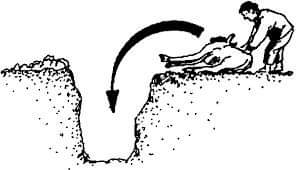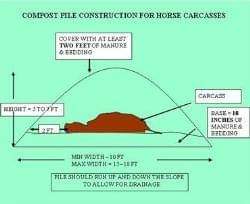DISPOSAL AND UTILIZATION OF DEAD ANIMAL CARCASS
Compiled & Edited by- DR. RK SINGH, JAMSHEDPUR
• The primary purpose of safe disposal of carcass is to ensure the check and spread of disease either to other susceptible animals or humans.
• Carcasses of animals may be disposed of by sending them to knackeries or by burial or burning.
METHODS OF DISPOSAL OF CARCASSES
- Burial method
- This is the most common method and is fairly safe if the burial pit is dug 2 meter deep or highest part of the carcass is atleast 1.5 meter below the level of surrounding terrain.
- Besides the carcass, left over feed by the dead animal, its bedding, excreta and top 5 cm soil floor are also buried with the carcass.
- Deep burial will prevent the jackals from digging up the carcass and insects from carrying the bacterial spores to the surface.
- Once the carcass is in grave, the skin is slashed and drenched with crude phenol.
- Then the carcass is covered on all sides with quick lime and filled with mud and topped with some concrete objects.
- In case of anthrax, before removing the carcass for disposal, all its orifices are plugged with cotton soaked in 5% cresol and body is wrapped in similarly soaked bag.
- The byre should be disinfected with 5% cresol using long handled brushes and then washed over with freshly chlorinated lime-wash.
- Burning or incineration methods
- Burning can effectively destroy carcasses.
- It can bee conveniently done in incinerator where a temperature of 600-800C is reached and all the organisms are destroyed.
- This method is quite suitable for animals that have died due to heat resistant microorganisms such as spores of Bacillus anthracis.
- If incinerator facility is not available, dead animals and other materials can be burnt in a pit, preferably dug near the site of death.
- The pit or trench (about 0.5 meter deep) is first filled with wood, making air spaces with the help of cross iron bars.
- Then the carcass is placed and ignited with the help of kerosene. After complete carcass is burnt, the trench is filled with mud.
- Chemical treatment
- If the animals die from diseases, which do not pose a potential health hazard, the carcass can be disposed of by usual means.
- Then the premises are treated with lime water (1:20) or with a suspension of bleaching powder (1:20).
- An aqueous solution of cresol or phenol is preferable for metal parts.
- Disinfection
- It is not enough to dispose of the animal died due to notifiable disease. All the related items and materials, which could serve as contaminating agents, are disinfected.
- Bedding straw, manure etc., should be buried, burnt or disinfected by mixing with slaked lime.
- Liquids such as blood, urine etc. should be disinfected with a 30% suspension of chloride of lime.
- For walls, floors, doors and tools, cleansing with lime-water (1:20) or with a suspension of bleaching powder (1:20) may be used.
- Metal tools or instruments of the abattoir may be disinfected by immersion in boiling water for this purpose.
- A 3% solution of washing soda (sodium carbonate) can also be used. Besides, hooks, handles, covers etc. should be scrubbed in boiling water or solution of washing soda.

BURIAL AND BURNING OF CARCASSES
Burial of carcasses
• Burial a suitable site should be selected. The burial place must be distant from a well or water course and there is a sufficiency of subsoil to allow a depth of 6 feet above the carcass.
• The carcass must be buried in its skin, be covered with a sufficient quantity of quicklime or other disinfectants.
• The dead animals should be arranged upon its back with feet upwards.
• The skin is slashed inside the pit all cases except ;in the case of anthrax.
• As the small of carcass may attract foxes and dogs the area of the burial needs to be disinfect with coal tar which will act as detergent for sufficient length of time.
Incineration/cremation/burning of carcasses
• There are 4 methods of cremation
o Pit method
o Surface burning method
o Flame gun method
o Incineration in a destructor
o
PIT METHOD
• Pit method for the carcass of a large cow, dig a pit measuring about 7 feet long, 4 feet wide and 18 inch deep is dug.
• A trench about 9 inches wide and 9 inches deep is next dug right across the bottom of the pit, the ends of this cross trench being the bottom of te pit, and sloped upwards so as to reach ground level about 2.5 feet from the edge of the pit.
• The object of this trench is to provide for draught and to facilitate the lighting of the fire. The fire may be laid in the following sequence.
o Fill the trench with straw soaked with paraffin to provide lighting points.
o Place a few piece of heavy timber, iron rails at intervals across the ventilation trench so as to prevent its obstructions.
o Cover bottom of pit with thin pieces of wood
o Add large pieces of wood
o Saturate with paraffin
o Add coal
• The fire is started by lighting the straw at one or both ends of the lighting points.
SURFACE BURNING METHOD
• This method can usefully be adopted when labour is scarce or when the nature of ground is not suitable for construction of pit ie., when the land is water logged.
o Two parallel trenches about 5 feet long, 9 inches wide and 9 inches deep and 2 feet apart are dug in the direction of the prevailing wind at the site selected for cremation.
o The carcass is placed over the trenches.
o Coal is placed on and around the carcass.
o Wood is soaked with paraffin.
o A small quantity of paraffin saturated straw is added, the fire is then lit.

FLAME GUN METHOD
• No pit or trench is required in this method. The carcass is placed on ground or corrugated iron sheet and a powerful flame directed towards it, destroy the carcass.
• The time taken depends on the number of flame guns used and the size of the animals.
Reference-On Request



